
|
||
|
Portland art blog + news + exhibition reviews + galleries + contemporary northwest art
|
||
In a Rhythmic Fashion at Hap Gallery 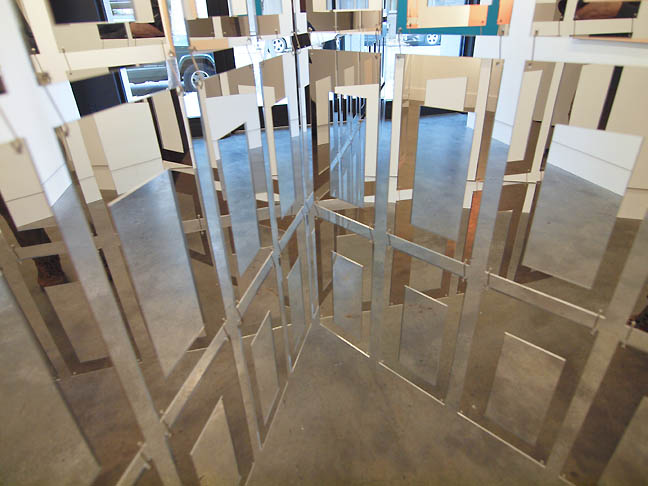 In a Rhthmic Fashion at Hap Gallery (all photos Jeff Jahn) On the whole the quality and sophistication of art exhibitions in Portland has improved in the last few years, but in that same time the # of fully realized, surprising and meticulously executed ones has declined as of late. The current Alien She, Seeing Nature and recent Ai Weiwei shows can be excluded because those are Museum shows... what I'm talking about are exhibitions by lesser knowns. Perhaps it is because most of the energy worth paying attention to here has fractured into small experimental spaces and individual artist studios where they save their best work and most realized efforts for exhibitions around the globe rather than at home? Portland has a lot of very active globally active contemporary artists. In fact, I've heard it straight from the artists themselves that they save their best efforts for elsewhere. Thus, despite the sudden spate of rent hikes Portland is still a great place to create and workshop experimental work among peers and export it. We are still far cheaper than other west coast cities. Still, venue-wise Portland can be weirdly conservative, half-baked or pedestrian/patronizing. Example: putting one or two humblebraggy objects in a white room. That's very weak sauce and curatorial studies 101. It means something has been missing and though I enjoy discussing the promising new artists who have just been discovered it is also nice to see a show that top to bottom owns and executes in a way that is clear, layered, challenging and resonant beyond the artist's statement and circle of friends. In other words, a truly world class show that you happen upon rather than expect has become rare when I used to happen every month or two. 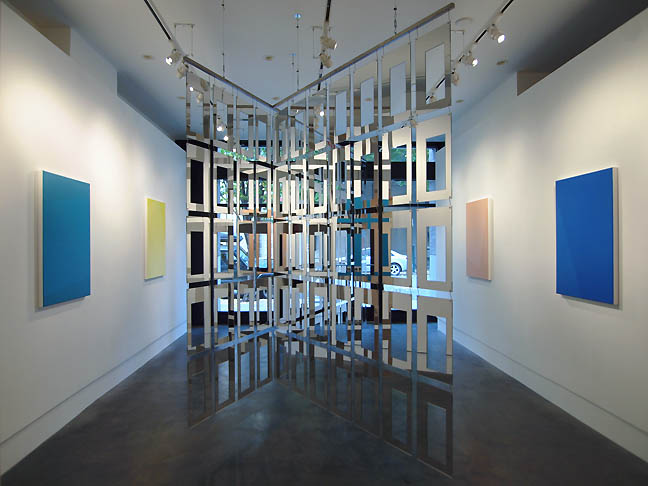 That's why In a Rhythmic Fashion at Hap Gallery is so satisfyingly complicated. The Belgian based duo Carla Arocha and Stephane Schraenen were brought over by Worksound and I couldn't be happier.
That's why In a Rhythmic Fashion at Hap Gallery is so satisfyingly complicated. The Belgian based duo Carla Arocha and Stephane Schraenen were brought over by Worksound and I couldn't be happier.
The exhibition consists of several intersecting scrim-like curtains of mirrored Plexiglas in the center of the gallery with monochromatic abstract paintings around the perimeter walls. The effect is far more than the sum of its parts as the mirrored curtains each has a rectangular window cut out of it. The resulting fenestation literally slices up and shatters the viewer's field of vision, while serializing it (not unlike a bug's compound eye or a modern building's curtain wall). In some cases it frames what is directly in front of you creating a portal. Other times, depending on where you are gazing the mirrors disrupts the view by reflecting the viewer and what is on the wall behind you. The artists mention Broadway Boogie Woogie but the real reference here are modern building techniques and architectural styles which inspired Mondrian in the first place. Instead the installation is not dissimilar to the non-sites of Robert Smithson, which also employed mirrors. In a Rhythmic Fashion therefore organizes the viewing experience by cutting it into pieces. I like the push and pull modality. 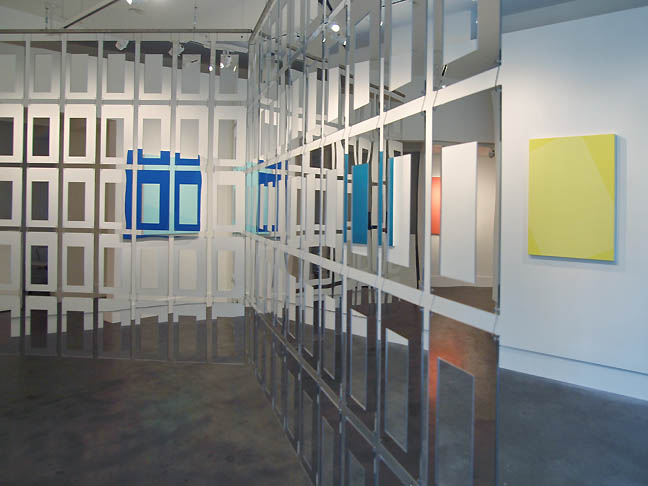
Overall, these rectangular segments and the inherent voyeurism remind me of the towering cliff faces that are condo buildings... something very much on Portlanders minds as gentrification and rents are steadily on the rise in many once quaint neighborhoods. But it also hyperfocuses you on the faces of others... as kind grounding visage in this house of mirrors. Some described this as pixelation, and it is when it reflects the colored paintings but in the case of human faces and forms the effect is a kind of human visual soup where depth of field becomes difficult to ascertain... a familiar or unfamiliar face in you field of vision could be someone behind you or on the opposite side of the room. Being a face in the crowd also means not standing out. This crystalline fragmentation also reminds me of another Smithson discovery... his describing of Donald Judd's "crystalline" structures and eventually the two went rock hunting together. This lead to Smithson's early Enantiomorphic Chamber works. Smithson's description of two of his crystaline works could well describe the effect at Hap Gallery: "Each framework supports the reflections of a concatenated interior. The interior structure of the room surrounding the work is instantaneously undermined. The surfaces seem thrown back into the wall. 'Space' is permuted into a multiplicity of directions. One becomes conscious of space attenuated in the form of elusive flat planes. The space is both crystalline and collapsible." -Robert Smithson, A Description of Two Crystalline Structures 1965 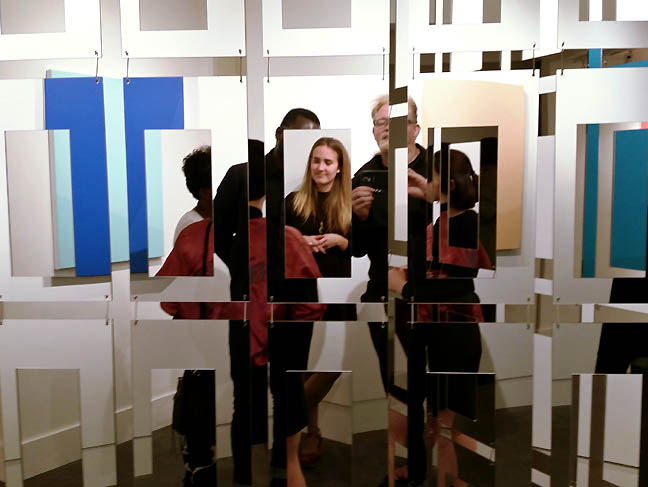
Though I think the intense delirium that Smithson supposes in his text was somewhat of a literary wish fulfillment, In a Rhythmic Fashion makes good and in many ways it may work better with more people in the room rather than less. Instead of Smithson's internal and quasi religious quest the artists at Hap Gallery have created a civic environment... a place that is just as distracting, constantly shifting and fragmented as our online personas. Humans are intensely social creatures and this exhibition points out the limitations of social practice... instead of a happening they present an environment and a kind of panopticon. The exhibition acknowledges the viewer by expressed discombobulation and I feel like it works better in the relatively small gallery space. This iteration is P11 and 10 previous versions have been staged all around the world, most recently P10 in Croatia. This stagecraft as experience has been a trend... begun arguably with Schwitters Merzbau but it was really Robert Irwin and James Turrell that turned experience into an instantly viable subject. What does it say about humanity? That as a species we would rather look at one another congregating or ourselves turned into a crowd than paying close attention to details? I'm not sure. There is also a Juddian lack of detail here due to great craftsmanship that does not call attention to its professional skill (rather than good craftsmanship, which screams notice me). 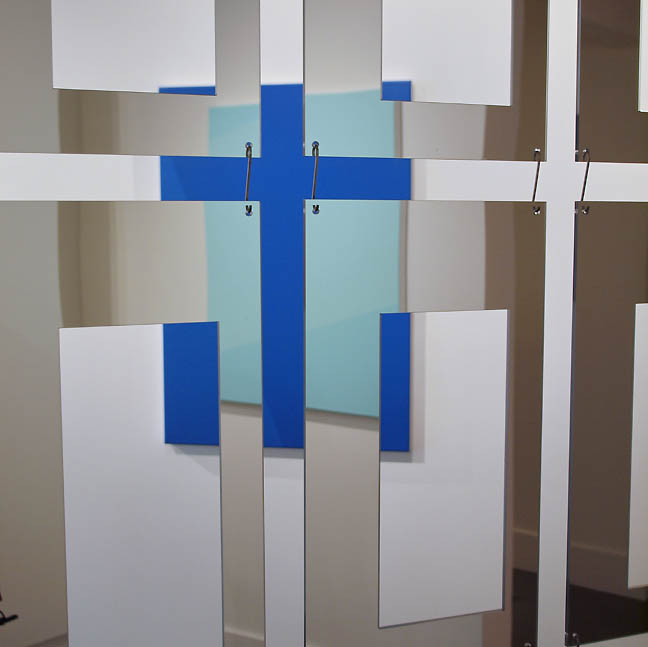
Technically this isn't a vain show but it does appeal to human vanity. You can see it is Instagram friendly and vanity does organize us in both group and interpersonal situations, while selfless contemplation (which I find here when I'm the only visitor) allows the space for new thoughts to float into consciousness. A polarity of vanity and transcendentalism is no easy task for any show. The fact that this exhibition with its commentary on architecture and its roots in abstract painting can be conversant on so many divergent levels is a sign of it's success. Best show of the year so far in Portland. Though November 14th at Hap Gallery, 916 NW Flanders Posted by Jeff Jahn on October 17, 2015 at 12:38 | Comments (0) Comments Post a comment Thanks for signing in, . Now you can comment. (sign out)
(If you haven't left a comment here before, you may need to be approved by
the site owner before your comment will appear. Until then, it won't appear
on the entry. Thanks for waiting.)
|
| s p o n s o r s |
 |
 |
 |
 |
 |
 |
 |
 |
 |
 |
 |
 |
 |
 |
 |
 |

|
Site Design: Jennifer Armbrust | • | Site Development: Philippe Blanc & Katherine Bovee | |

